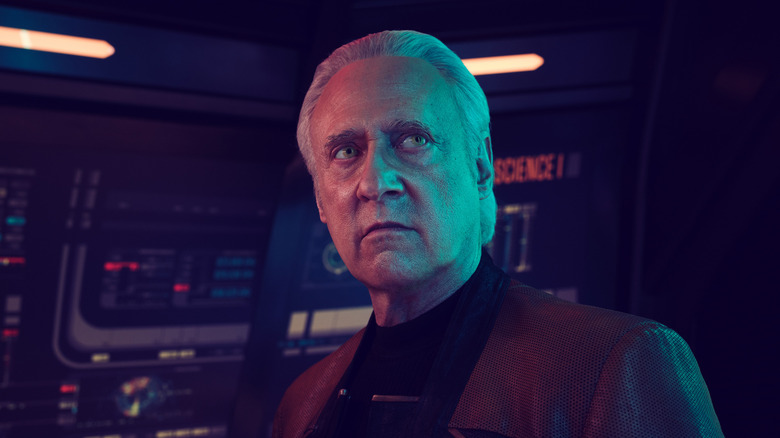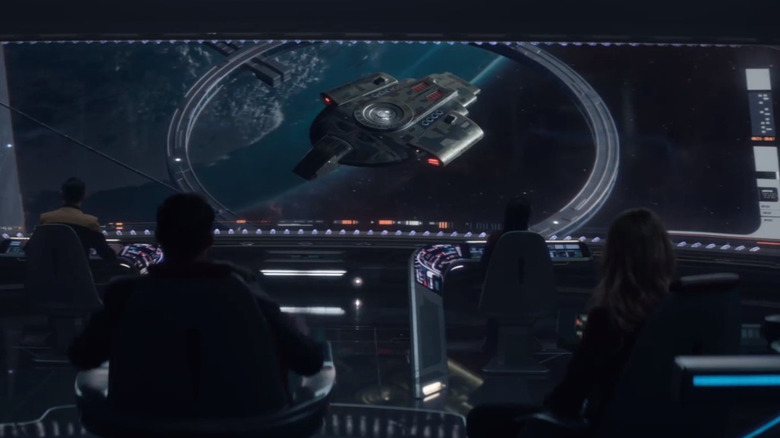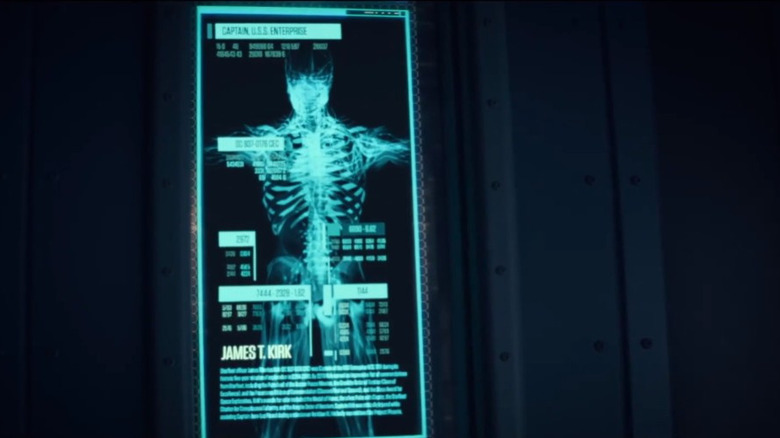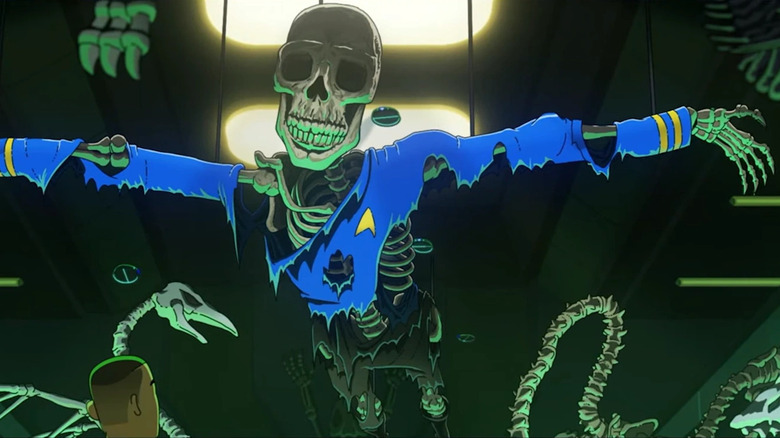Star Trek: Picard Season 3 Proves There Is Such Thing As Too Many Easter Eggs
This post contains spoilers for episode 6, season 3 of "Star Trek: Picard."
The most recent season of "Star Trek: Picard" initially sold itself as essentially a reunion special. Early trailers boasted that most of the main cast of "Star Trek: The Next Generation" would return, including Michael Dorn, Gates McFadden, Jonathan Frakes, LeVar Burton, Marina Sirtis, and Brent Spiner (even though Data had died several times over). While some Trekkies may have been excited about the promise of a reunion, other more cautiously pessimistic fans could immediately envision a plodding nostalgia-fest wherein characters do nothing but repeat old lines of dialogue, walk around on old sets, and become weepy over the tricorders they used several decades prior.
Quite mercifully, in the new season's first five episodes, the nostalgia has been relegated to a mere steady drip. The "Next Generation" characters have been introduced slowly, making the reunions more organic. Additionally, they have all been allowed to grow up a little since audiences last saw them in "Star Trek: Nemesis," making the relationships strained rather than warm. This has made for better drama and better storytelling in general. Even when Ro Laren (Michelle Forbes) was brought back in episode five, it was handled with tact rather than nostalgia. It was fitting that Picard (Patrick Stewart) kind of hated her now. When the Changelings from "Deep Space Nine" were re-introduced, it was more mysterious than exploitative.
Episode six, however — called "The Bounty" — seems to have collapsed under its own restraint. "The Bounty" goes full-bore nostalgia, throwing in dozens of Easter eggs, cameos, and old-world "Star Trek" ships included for no other reason than for Trekkies to point in recognition. Frankly, it's embarrassing.
The Easter eggs museum
At this point in the series, Worf (Dorn), Riker (Frakes), Crusher (McFadden), Picard, and Geordi La Forge (Burton) have all reunited thanks to the dictates of the season's plot. Worf and Raffi (Michelle Hurd) have been investigating who stole a particularly dangerous piece of technology from the Daystrom space station. That station happens to be located next to Earth and right by a well-regarded Starfleet ship museum. La Forge has become the curator and maintainer of said museum, allowing him to enter the story. While Worf, Riker, and Raffi break into the Daystrom station, Jack Crusher (Ed Speleers) and Seven of Nine (Jeri Ryan) stay on board the U.S.S. Titan and look out over the ships in the museum.
A painful amount of time is spent looking at the ships. Seven scrolls through a database, and she and Jack comment on each of the ships that come up. Each ship comes with its own musical quotation from the series or movie in which it appeared. The U.S.S. Defiant gets a few strains of Dennis McCarthy's theme song. The Voyager gets the same from Jerry Goldsmith. Seven wistfully recalls it at the place where she was reborn. Jack looks at the Enterprise-A, last seen in "Star Trek VI: The Undiscovered Country," and declares himself to be "a Constitution-class man." Even the H.M.S. Bounty, the Klingon ship used in "Star Trek IV: The Voyage Home" appears, and it is implied that its still-working cloaking device may come in handy.
Each musical cue elicits nostalgic mistiness as well as bitter resentment. Trekkies do love canon references and have a sci-fi machine fetish — we practically invented the practices — but this kind of wallowing in the past is self-indulgent, even for a series called "Star Trek: Picard."
The Easter egg institute
Even a moment's thought might have Trekkies questioning the very need for a starship museum. While it may be historically valuable to retain a few ships for their significance, I personally always got the impression that Starfleet vessels were recycled. Some of these ships are enormous, and the actual raw materials needed to make them can't be infinite. As such, surely the Utopia Planitia shipyards would constantly be receiving decommissioned ships to salvage for parts. Also, on "Picard," the ships appear to be constantly powered up, their lights shining through their windows and their warp engines lit. Are the ships always powered up and ready to go? Is life support on? Why use all that power to keep a century-old ship flight ready when there's no crew to operate it and no missions for it to go on? In light of these admittedly nerdy questions, the whole ship museum sequence emerges as gross pandering.
Also pandering are the scenes on board the Daystrom station. It was established in the previous episode that Daystrom station is protected by an artificially intelligent security system that, as it turns out, adapts itself to the people breaking on board. When the station sees Worf and Riker sneaking inside, it initiated a security hologram program that resurrects the Sherlock Holmes villain Moriarty (Daniel Davis). This is a reference to two "Next Generation" episodes wherein the Enterprise accidentally created a sentient holodeck character that, in one instance, tried to take over the ship. There is no real reason for the character to appear on Daystrom station other than that Riker — and the audience — might recognize him.
The joy of reference
While Riker, Worf, and Raffi are sneaking around the institute, they creep past any number of Easter eggs and references, passing lockers containing, say, the remains of Capt. Kirk, salvaged from the Veridian system. Worf finds a locker with a tribble in it, despite a story he told on "Deep Space Nine" where the Klingons destroyed the tribble homeworld. "Picard" is implying that every artifact from "Star Trek" has been stored here. The references and the corresponding theme music are insufferable, and they introduce strange new wrinkles into "Star Trek" lore. Why, for instance, keep a tribble in a space station? Either it's too dangerous to proliferate, or it's an extinct species that can be resurrected. Having one squirreled away in a remote secret locker doesn't help anyone.
I want to state openly, however, that the references on "Picard" are of a different flavor than the many, many references one might find on any average episode of "Star Trek: Lower Decks," the animated series. It's notable that "Lower Decks" is a comedy series that plays openly with the usual formalism seen throughout "Star Trek." The characters are all ensigns, often called upon to do the most undignified jobs on a starship that has little to no prestige in the Federation. When massive elements of extant Trek lore appear on "Lower Decks," it serves as a comedic juxtaposition of the characters' smallness. Fans recognize it, but then the characters run past it, and we all have a hearty chuckle.
"Picard" has no such humor, hanging its references with sticky, undue reverence. Just because a character, a ship, or a piece of technology is important to us the viewers, doesn't mean the characters would treat it the same. Trekkies can smell inorganic references a mile away.



